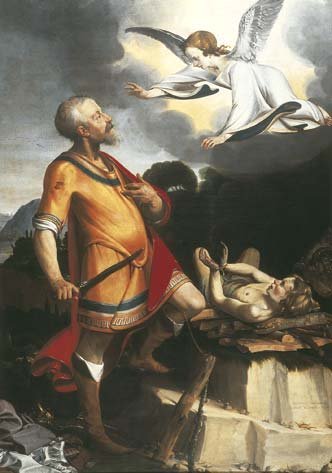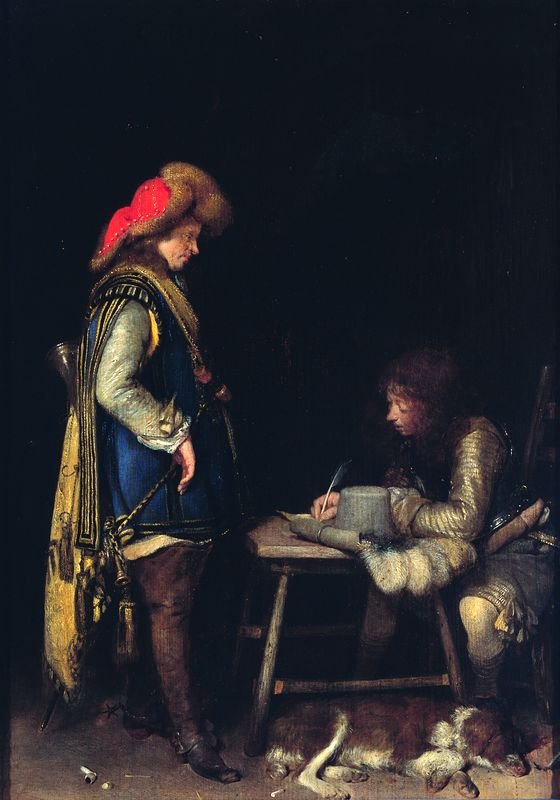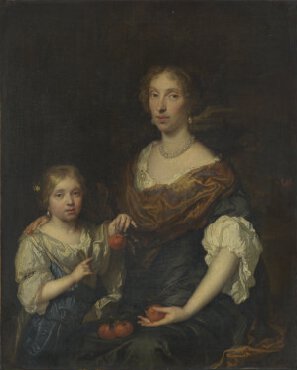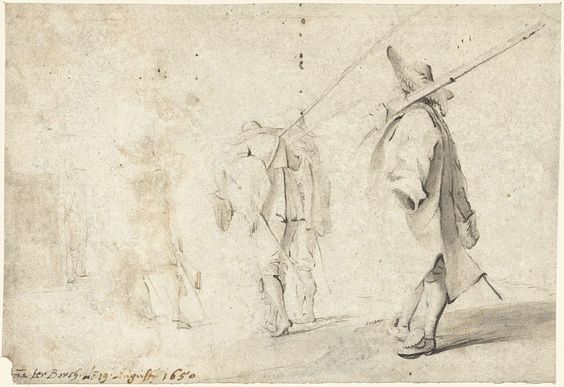
Today I am looking at a dynasty of Dutch artists – the ter Borch family. The head of the family was Gerard ter Borch the Elder who was born in Zwolle in 1583. At the age of eighteen he travelled to Italy and stayed in Rome and Naples for the next eleven years drawing and painting local landscapes. On his return to his home town of Zwolle he married Anna Bufkens and five years later, in 1617, she gave birth to their son Gerard.

During his final years in Italy and after his return to The Netherlands, many of the paintings by Gerard ter Borch the Elder featured scenes from the Bible, one of which was his 1619 painting entitled The Sacrifice of Abraham.

Gerard ter Borch the Elder was a talented draughtsman and this can be seen in his drawing, Head of a Girl, which he completed around 1628 and is thought to be a portrait of Sara, his daughter (by his second wife) who was four years old at the time.

Ter Borch the Elder, like many artists of the time used family members as their models and again we can see an example of this in another of his pen and ink drawings entitled Head of a Little Girl Wearing a Necklace.

A third example of Ter Borch’s draughtsmanship is his 1630’s work entitled Little Girl at a Table Holding a Slice of Melon. This small (12 x 9cms) drawing is done using black chalk, brown ink washes and black ink. The brown wash is used to shade one side of the girl’s face and to cover the background. This wash reinforces the effect of light falling on her face and her clothing. The girl stares off to the right of the painting at something which is fascinating her. Other items of food lie in front of her. She is dressed simply, wearing a wide white collar over her dress. Her hair is tied behind her head with a bow, but some loose strands have escaped and lie across her forehead.
In the late 1630’s Gerard ter Borch the Elder almost gave up his painting although he did oversee the artistic education of his children.

The eldest of the Ter Borch children was Gerard ter Borch the Younger, the only child from his father’s first marriage to Anna Bufkens, and I suppose if I was to talk about a Dutch artist by the name of ter Borch you would probably assume that I was referring to Gerard ter Borch the Younger as he was probably the most accomplished member of this talented and prosperous Dutch artistic family. He was born in Zwolle in 1617. His mother died when he was just four years old and was looked after by his father. Gerard Junior proved to be a talented painter even before his teenage years. In 1632, he went to Amsterdam to study painting and two years later, when he was seventeen years old, he went to Haarlem to study with the painter and engraver Pieter de Molijn and there, he entered the Guild of St Luke of Haarlem the following year.

In 1635 ter Borch the Younger travelled to London where he worked alongside his uncle, Robert van Voerst, the royal engraver of Charles I. Many of his travels took him to Italy, France and Spain, the latter visit being an invitation to the Spanish royal court to produce a portrait of King Philip IV which gives you an idea as to how highly he was thought of as an artist. Ter Borch received a knighthood and a gold chain and medal from the king of Spain for his artistic efforts.

Around 1646 Gerard Ter Borch the Younger was living in Münster, Westphalia, and it is here he completed one of his most famous paintings, The Swearing of the Oath of Ratification of the Treaty of Münster which can be seen in the National Gallery in London. The Treaty of Munster, which was signed in May 1648, was a momentous time in the history of The Netherlands as it finally recognised the country’s independence. This treaty and the treaty signed in Osnabruck ended the Thirty Years’ War between 1618 and 1648 in the Holy Roman Empire, and the Eighty Years’ War between 1568 and 1648 between Spain and the Dutch Republic, with Spain formally recognizing the independence of the Dutch Republic.

The oil on copper painting is set in the Ratskammer (council chamber) of the Town Hall of Münster and depicts the portraits of seventy-seven men. In the foreground, standing behind the table, dressed in black, we see the six Dutch delegates. To the right of the table stand the two Spanish. Both sets of men are ratifying the treaty simultaneously. A Franciscan monk stands behind the Spaniards on the extreme right. What appeals to me about this work is that Ter Borch has taken the liberty of including himself in the work on the far left, gazing out at us!!!!
In his earliest works, Ter Borch depicted barrack-room scenes whereas most of his later genre scenes, focused on the more refined elements of Dutch society.

Gerard ter Borch the Younger was also a leading proponent of genre scenes often featuring depictions of soldiers at rest in their barracks or the local taverns. These works were generally small and upright in format and typically depict two or three elegantly clad, full-length figures engaged in an activity such as letter writing or music making. The depiction of letter writing was extremely popular. The reason for this probably stems from the belief that letter writing was predominately a form of relaxation among the middle and upper classes and these social classes had expanded during this period which saw the Dutch economy prosper. An example of this is his 1658 work Officer Dictating a Letter. They are executed with great sensitivity of touch and show an interest in the psychology of the sitters.

Ter Borch also painted many small-scale, full-length portraits. His most important student was Caspar Netscher (Dutch, 1639 – 1684), who learned many of his master’s techniques for rendering luxurious textures and who painted, in addition to his original compositions, many signed copies of Ter Borch’s works.

Later in the 1650’s he often depicted more genteel scenes featuring wealthy members of Dutch society. One such painting was entitled The Concert: Singer and Theorbo Player which he completed around 1657 and can now be found in The Louvre. The setting is a cosy and relaxed bourgeois interior. Hanging in the background we see a large luxuriant tapestry. The table in the left foreground is covered by a sumptuous oriental carpet with its colourful, geometric design that appealed to northern painters and which signified the wealth of the household. The two young women in the painting are giving a musical performance. The lady standing on the left is playing a theorbo, a plucked string instrument of the lute family. Seated at the table is her companion who is following the score, her hand is raised as she beats the time presumably as she prepares to break into song. On the right of the painting, and looking towards us, is a young servant who has brought the ladies a glass of beer on a tray.

Another genre work from around 1654 by Gerard ter Borch the Younger was A Maid Milking Cows in a Barn. In the barn, we see a young woman squatting down in the process of milking a brown and white spotted cow. Another cow stands close by, waiting its turn. This work is a classic example of the ability of the artist to expertly depict different textures. Look at how he has portrayed the various objects dotted around the foreground of this work such as the jaggedly sculpted stool and the wooden basin which is filled with water. Look too at the chipped ceramic crock pot, and the shiny metal hinges of the buckets. The painting is housed in the Getty Centre, Museum East Pavilion in Los Angeles

Gerard ter Borch the Younger also painted many small-scale, full-length portraits such as the pendant portraits he completed around 1667 of Jan van Duren, a member of the upper ruling class of the Dutch town of Deventer and his wife Margaretha van Haexbergen. Van Duren is dressed in the opulent clothing one associated with an affluent regent and in the other work, his wife is equally well adorned.

In both cases the background is bare which avoids anything that may have detracted from the subject/patron and in the same way, the settings are minimal with just a simple velvet covered table, atop of which is a hat, in one and a fringed velvet chair in the other. The overall appearance of both portraits is one of simplicity, elegance, and dignity.

Another of Gerard ter Borch’s portraits is one entitled Gerbrand Pancras, Formerly Known as Hendrick Casimir II, Prince of Nassau-Dietz which is housed mat the Manchester Art Gallery. The three-quarter length, three-quarter right-side portrait is of a young man dressed in blue and silver clothes which are decorated with pink ribbon. The man stands looking out at us, some would say condescendingly, with a silver-topped walking stick in his right hand whilst his left-hand rests on his hip. Lying to the side of him is a table, covered by a red cloth, on which is a black hat dressed with a white feather. The inscription states that he is 12 years old.
Anna Bufkens, the first wife of Gerard ter Borch the Elder and the mother of Gerard ter Borch the Younger died in 1621, aged 34. Shortly after the death of his first wife, ter Borch the Elder re-married. His second wife was twenty-two-year-old Geesken van Voerst. The couple went on to have two daughters, Anna in 1622 and Sara in 1624. It was around this time that Gerard Snr’s painting output declined although he would still afford his children artistic training. He also assumed the position held by his aged father, Harmen, the Licencemaster of Zwolle, a position Gerard ter Borch the Elder would hold for about 40 years until his death.

Seven years later, in 1628, Gerard ter Borch the Elder’s second wife died aged just twenty-nine years of age. Following shortly on from her death, forty-five-year-old Gerard married for a third time. His third wife was twenty-one-year-old lady from Deventer, Wiesken Matthys. There seems some doubt about how many children they had ranging from five to ten but I found that they had a daughter Gesina in 1631, a daughter Catharina in 1634, a son Harmen in 1638, a third daughter Jenneken in 1640 and a son Moses in 1645. There was also talk about another son Mattijs but I cannot find a birth date for him.
Gesina ter Borch was born on November 15th, 1631 at the family home in Sassenstratt in the town of Zwolle, where she would live all her life. She was the eldest child of Gerard ter Borch the Elder and his third wife, Wiesken Matthijs. When her father died in 1662 and her brothers had left home, she lived in her parental home with her mother, sister Catharina and her late sister, Jenneken’s three children. She never married.

Gesina became a great talent in the art of draughtsmanship and when she painted she favoured the medium of watercolours. Her paintings which were mainly for her and her family’s pleasure and were usually small in size but vibrant in colour. She had not received any formal artistic training except for the tuition afforded to her by her father who had also taught his sons, Gerard the Younger, Harmen and Moses.

Gesina over time collected her pen and ink and watercolour drawings as well as her poetry in three albums, Materi-Boeks, the first of which was begun in 1646 when she was just fifteen years of age. Her art books were a combination of her art and her scrapbook. She printed drawings of her family members, newspaper clippings, children’s and friends’ artwork, and many copies of her half-brother Gerard’s work and that of her brother Moses.

The one painting she is probably best known for was her posthumous portrait of her youngest brother Moses ter Borch which is in the Rijksmuseum. It was a collaborative work with her step brother Gerard ter Borch the Younger. Moses, who was born in 1645 and died in 1667, aged twenty-two, during the storming of Fort Languard near Felixstowe in England. He had served in the Dutch navy which had been fighting against the English since 1664. It is a painting full of symbolism and meaning. Time is alluded to by the inclusion of a pocket watch, death is symbolised by the skull, loyalty by the inclusion of a small lap dog looking lovingly at his master and eternity by the depiction of the ivy on the rocks. Moses ter Borch was buried in Harwich.

In the above collaborative portrait, one can tell that Gesina’s stepbrother Gerard probably was the greater of the two contributors to the work but a quite simplistic portrait of her brother and his death can be seen in her painting which was part of one of her albums.

Moses himself was also an artist and when he was about sixteen years of age completed a self-portrait.

He also completed many sketches, some were oil sketches like his very small (8 x 7cms) work with the strange title, Self Portrait, the so-called Portrait of Jan Fabus which he completed in 1661.

The final artist of the family was Harmen ter Borch. He was the eldest son of Gerard ter Borch and his third wife, Wiesken Matthys and the sister of Gesina and Moses. There are several his sketches in the Rijksmuseum including one depicting soldiers which he completed when he was just twelve years old.

Another, the Beestenconcert was completed in 1653 when he was fifteen years old.

But probably my favourite is his colour sketch entitled The Broken Bridge which he painted in 1655 when he was seventeen years old
With such a number of artists in one family, one wonders whether family life was a very competitive environment. Gerard ter Borch the Younger was by far the greatest of the family artists but it is good to remember that he had some talented siblings.
